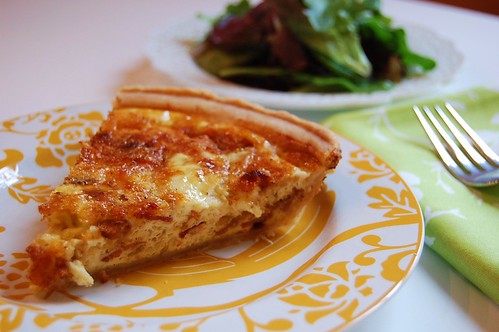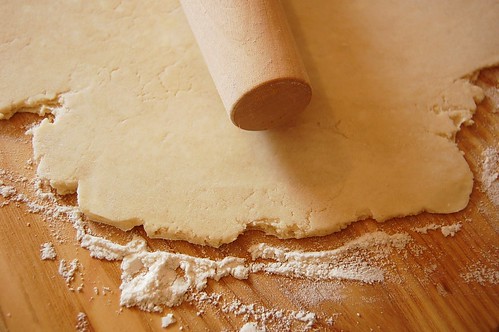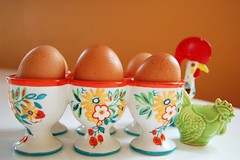Well, golly. It’s back to the ol’ routine after a great holiday break. I hope everyone had a fun, relaxing and restful holiday! I spent part of the holidays visiting my relatives in the sleepy southern Georgia town of Americus, where it’s OK to park it on the couch for hours at a time, eat endless amounts of Aunt Robbie’s fudge, help Grandbetty with her jigsaw puzzle and yell out the answers during the daily Wheel of Fortune watch party. Life there is sweet and simple – a lot like the iced tea that is consumed daily by the gallons. Now, two weeks later, five pounds heavier and five days into the New Year, my batteries are recharged and my outlook is bright. 2010 is going to be a great year, y’all. On with the show.
For the second installment in my Foodie 101 series, I thought I would expound a bit on the subject of quiche. Known universally as a classic French dish, quiche is a savory egg custard that’s flavored with various meats, cheeses and vegetables, and baked in a short crust until puffy and browned. Quiche gained popularity in the United States in the 1950s, and for whatever reason, was eventually typecast as a haughty, effeminate “sissy dish” over the subsequent decades. I’ve never really understood what this unfounded label was about – if we called it Egg Pie, would that make it a manlier and more gallant dish? Who knows. I say if it’s good, eat it – whatever it’s called.
Quiche is very versatile fare – it can be eaten for breakfast, brunch, lunch or even dinner. Heck, you could even get crazy and make it dessert (eggnog custard pie, anyone?) Around our house, we like to serve a warm slice over a bed of salad greens, which is really tasty, satisfying, and even has the illusion of being healthy. Quiche can have an infinite number of fillings: bacon, ham, chicken, broccoli, spinach, sundried tomatoes, the list goes on and on – and that’s not even mentioning the cheese!
A simple quiche combination is bacon, onions and Swiss cheese, otherwise known as the classic and dignified Quiche Lorraine. Now, according to some (including the famous and fabulous Julia Child), traditional Quiche Lorraine consists of only eggs, cream and bacon. Add onions, and you’ve got Quiche Alsacienne. Add cheese, and well, that’s just blasphemy. But over the decades, Quiche Lorraine has morphed into the classic combination mentioned above, and it’s one that’s hard to beat.
I also thought I’d multitask here and provide anyone who’s curious with a great made-from-scratch short crust recipe, otherwise known as the clumsy-to-pronounce pâte brisée. Pâte brisée is a simple French pastry dough, and because of its lack of sugar, can be used on both sweet and savory dishes, making it a very versatile pastry. The patience, extra work and attention are definitely worth it. Come on, you’re only four ingredients away from a delicious, homemade, super-flaky crust.
With just a few ingredients, a couple of hours and a little elbow grease, you too can make your very own Quiche Lorraine. Better yet, be adventurous! This recipe is your baseline upon which to explore: try different fillings, like goat cheese and spinach, roasted potatoes and leeks, sausage and bell pepper. The possibilities are endless. When it’s this delicious, anyone – including real men – will eat quiche. Enjoy, and bon appétit!
Quiche Lorraine
(makes one 9″ quiche)

5 bacon slices, cut into medium sized pieces
1/2 large onion, diced
5 oz. Swiss cheese, shredded
6 eggs
1 c. milk or half and half
1 pâte brisée crust, baked blind (recipe to follow)
salt and pepper to taste
Preheat the oven to 425°. Place a rolled out pâte brisée crust (about 12″ in diameter) in a 9″ pie pan, crimping the sides. Place another 9″ pie pan over the crust and bake for 10 minutes, until the crust begins to become flaky. Remove from the oven, remove upper pie pan, and cool.
Turn the oven heat down to 375°. In a large skillet, cook the bacon pieces until crisp and brown. Discard all but 2 Tbs. of the bacon grease. In the same pan with the 2 Tbs. of reserved bacon grease, sauté the onions over medium heat until translucent and beginning to brown, about 10 minutes. Turn off the heat and set aside.
In a medium bowl, combine the eggs and milk (or half and half) and whisk thoroughly to combine. Season with salt and pepper.
Arrange the bacon and onions in the pie crust, and top with Swiss cheese. Carefully pour the egg mixture over the crust. Bake the quiche for 45-50 minutes, until the crust is golden and the eggs are puffed and golden brown. Remove from the oven and allow to cool. Serve warm or at room temperature.
Pâte brisée
(makes one double crust or two single crust 9″ pies)

2 1/2 c. flour
1 tsp. salt
2 sticks very cold butter, diced
1/2 c. ice cold water
In the bowl of a food processor, combine the flour and salt. Add the butter, and pulse the mixture until the texture resembles coarse crumbs with some larger pieces remaining. With the machine running, add the water through the feed tube in a slow, steady stream, just until the dough holds together without being too wet or sticky.
Turn the dough out onto a clean work surface. Divide the dough in half, and wrap each half tightly in plastic wrap. Shape into flattened disks. Refrigerate dough at least one hour before rolling. Dough can be frozen for up to 3 months.
Rolling tips:
- Roll the dough on a flat, well-floured surface
- Keep the dough moving. Rotate the dough every three or four rolls to ensure even thickness
- Roll the dough from the center outward
- To place the dough in the pan, fold the dough into quarters, place it in the pan and unfold
View the slideshow below or visit the entire set at Flickr.
Laura Hobbs is a guest contributor for the Fayetteville Flyer. She was born and raised in Fayetteville. She is a self-proclaimed foodie and avid cook. For more of Laura’s contributions, visit her author page.


